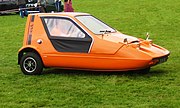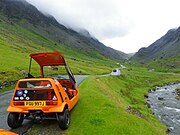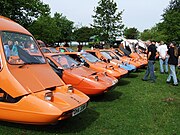Bond Bug
| Bond Bug | |
|---|---|
 | |
| Overview | |
| Manufacturer | Bond Cars Ltd /Reliant |
| Production | 1970–74 2,270 made[1] |
| Assembly | |
| Designer | Tom Karen (Ogle Design) |
| Body and chassis | |
| Class | Microcar |
| Body style | canopy door coupé |
| Powertrain | |
| Engine | Reliant 700 cc I4, later 750 cc I4 |
| Transmission | 4-speed manual |
| Dimensions | |
| Wheelbase | 6 ft 5 in (1,956 mm)[3] |
| Length | 9 ft 2 in (2,794 mm)[3] |
| Width | 4 ft 7 in (1,397 mm)[3] |
| Height | 4 ft 2 in (1,270 mm)[3] |
| Kerb weight | 868 lb (394 kg) |
| Chronology | |
| Predecessor | Bond 875 |
The Bond Bug is a small British two-seat, three-wheeled automobile which was designed by Tom Karen of Ogle Design for Reliant Motor Company, who built it from 1970 to 1974, initially at Bond Cars Ltd factory, but subsequently at Reliant's Tamworth factory. It is a wedge-shaped microcar, with a lift-up canopy and side screens instead of conventional doors.
History[]
Early beginnings[]
Since 1962, when Reliant Motor Company launched the Regal 3/25, the company had tried to make a more sporty version to appeal to a younger buyer. Design sketches were done as early as 1964 by Ogle; these sketches are much more wedged shaped with some rounded edges; the original name for this car was the Reliant Rogue.
The car was never put into production, as management thought that such a strange-looking vehicle might hurt the Reliant brand identity.
Bond cars buy out[]
Following the purchase of Bond Cars Ltd. in 1969, Reliant commissioned Tom Karen of Ogle Design to alter the Reliant Rogue design; the car would now become a Bond vehicle. The Bond Bug was based on chief engineer John Crosthwaite's newly designed chassis,[4][5] and used a mixture of Reliant Regal parts, and running gear which had been designed for the Reliant Robin 750, which was due to be launched in 1974. The original concept was explored by chopping down a production Regal vehicle, the rear of the car being shortened to end over the rear axle.[citation needed]
The engine is the front-mounted 700 cc Reliant light-alloy four-cylinder unit, later uprated to 750 cc. At launch, 29 bhp (22 kW; 29 PS) was claimed for the less expensive 700 and 700E models. The more upmarket 700ES incorporates a redesigned cylinder head, which permitted the compression ratio to be increased from 7.35:1 to 8.4:1.[6] This provided a power increase to 31 bhp (23 kW; 31 PS) as well as improved torque for the then range-topping 700ES.[6]
The Bond Bug 700ES also offers more ergonomic seats, as well as more padding over the engine cowl, twin mudflaps, an ashtray, a rubber front bumper and a spare wheel.[6]
Launch and production run[]
The car had an upbeat launch, at which Reliant's Ray Wiggin stated: "The fact it has three wheels is quite incidental. It's a new form of transport. So now, in fact, we think it's going to appeal to a much wider section of the market than we originally envisaged."[6]

The Bug was available in a bright orange tangerine colour, although six white Bugs were produced for a Rothmans cigarette promotion – one of which was also used in an advertisement for Cape Fruit. Only three Rothmans Bugs are known to exist.
In contrast to the image of three-wheeled Reliants as being slow, the Bond Bug was capable of 76 mph (122 km/h), in excess of the UK national speed limit (70 mph/112.6 km/h), and comparable to small saloon cars such as the basic 850 cc Mini (72 mph/116 km/h) and the Hillman Imp (80 mph/128 km/h). However, it could not match the speed of the Mini Cooper S (96 mph/154 km/h) or larger saloons such as the Ford Cortina Mark III (104 mph/167 km/h in the highest-powered variant), or even aging models of two-seater sports cars, such as the MG MGB (103 mph/165.7 km/h) or the Lotus Seven, where by 1970 even the lowest-powered version of the S4 could reach 108 mph/173.8 km/h.[7][8]
The Bond Bug was sold as being fun to drive, with the low seating position giving a similar exaggerated impression of speed as in a go-kart, while the actual speed was similar to that reached by high performance cars only a few years earlier (indeed, earlier versions of the Lotus 7 had a top speed of 76 mph/122 km/h right up until 1968, and their trim level, e.g. side curtains instead of windows, was also similar).[7]
The Bug was, however, no cheaper than more practical cars. It cost £629, while a basic 850 cc Mini, a four-seater much faster round corners but with considerably inferior acceleration, cost £620. Also, while a basic Lotus Seven (with much faster acceleration and good cornering) cost £945 in 1970,[8] it was also available as a complete knocked down kit much more cheaply, partly because of more favourable tax treatment.[citation needed]
Reliant launched the Bond Bug 750 in late 1973 but production ended after less than 200 Bug 750s sold, as Reliant ended all other production lines so more capacity could be made open to build more of the newly launched Reliant Robin 750 to keep up with demand.
Further development[]
Even though the Bond Bug ended production with little fanfare, Reliant continued development into the 1970s; prototype 4-wheeled Bond Bugs were made before the launch of the Reliant Kitten, as they thought a 4 wheeled version may have more appeal to the market. The code name FW9 was used for the 4-wheeled Bond Bug design studies, later leading to a prototype of a strange coupe that looked very different from the Bond Bug. All this design was done by Ogle, but Reliant management never took it any further.
A larger engine was also in development with BRM for the car too; this was a standard 850cc engine block with a overhead camshaft design; this engine would also gain twin SU carburettors and an electric fuel pump; the engine in standard tune would give 70hp. The engine was meant to be shared with a small production sports car that Reliant never finished developing.
Webster Bug[]

Mike and Gary Webster between them managed to acquire the original Bug moulds from Reliant Motor Company in 1990 with a licence for the design, and formed the "Webster Motor Company".
They decided to produce 4 wheeled Bugs as a "Kit car", so you would build the vehicle yourself. The kit asked you to buy a Reliant Robin or Rialto for the majority of donor parts, or the whole car could be supplied as one kit with a mixture of new and refurbished parts.
To allow the Bug to have 4 wheels, the ladder chassis was cut down at the front, with a Mini front subframe welded in place. The moulds were also changed to have two large arches at the front. Different models were developed, including convertible versions that had no lift up canopy with small screens, or a standard car which had fibreglass doors instead of the original vinyl doors, to keep the driver warm and dry.
They also produced a small number of 3 wheeled Webster Bugs
Under 30 kits were known to be sold.
Reliant Sprint[]
In 1994, Reliant unveiled the "Reliant Sprint"; this car was a complete redesign of the original Bond Bug. Tom Karen of Ogle design rounded off all the sharp edges of the Bug and added round headlights giving the car a totally new look; the prototype had Minilite alloy wheels, a grey vinyl interior, and was bright yellow. The Sprint used, in effect, a Reliant Robin chassis cut in half, with the rear half made to use the original suspension set up of the Bond Bug. Similarly, the interior used many of the current Robin switches and dials, to keep production costs low.
As shown in the Trouble At The Top TV show, Reliant Management wouldn't allow Jonathan Haynes to put the Sprint into production, as they had little faith that, in the 1990s, it would sell in any large numbers, even though it would cost as little as £12,500 to start production.
More developments were made on the Sprint until 1998, when Reliant would try to get it production-ready as a 4-wheeled sports car. Andy Plumb would redesign the car, now renamed/code named internally "the Clubman", in 2 different 4-wheeled models: a standard car and a convertible. These cars had huge bubble-shaped front and rear arches. Again more prototypes were produced; the chassis was redesigned once more with double-wishbone front suspension, and because the car was a 4-wheeler, the 850cc engine was redesigned to take fuel injection and a catalytic converter. Even though prototypes were promising, Reliant Motor Company wouldn't pay for further development, and the project died.
Popular culture[]
Tom Karen oversaw the design and production of Luke Skywalker's landspeeder from Star Wars (1977): one of the models was built upon the chassis of a Bond Bug – the wheels hidden by mirrors angled slightly to the ground.[citation needed]
Gallery[]

Bond Bug side view with the canopy closed

Bond Bug with canopy open and Honister Pass in View
Bond Bug 40th Anniversary gathering at Woburn Abbey, 2010

Bond Bug on the Reliant Stand at the 2011 NEC Classic Car Show in Birmingham
See also[]
References[]
- ^ "Vehicle Modifications By Chassis Number". The Bond Owners Club. The Bond Owners Club. 2001. Retrieved 27 September 2012.
- ^ Jump up to: a b A brief history of the Bond Company, www.bondownersclub.co.uk Retrieved 4 July 2015
- ^ Jump up to: a b c d Culshaw; Horrobin (1974). Complete Catalogue of British Cars. London: Macmillan. ISBN 0-333-16689-2.
- ^ Autocar magazine 4 June 1970 (Bond Bug)
- ^ "Bond Bug". dune buggies and hot VWs. November 1970. p. 36.
- ^ Jump up to: a b c d Harold Hastings (6 June 1970). "The Bug". Motor. pp. 28–38.
- ^ Jump up to: a b "Octane classic car specs". Archived from the original on 24 October 2013. Retrieved 28 October 2013.
- ^ Jump up to: a b "Lotus 7 – Series Four Page – Original Specifications". Lotus 7 Register. Retrieved 28 March 2013.
External links[]
| Wikimedia Commons has media related to Bond Bug. |
- Bond vehicles
- Microcars
- Rear-wheel-drive vehicles
- Reliant vehicles
- Three-wheeled motor vehicles
- Cars introduced in 1970



